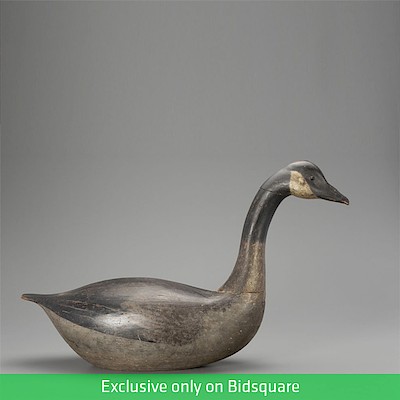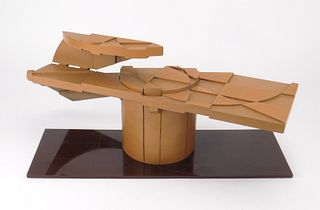Important Calling Tern, A. Elmer Crowell (1862-1952)
Lot 1
About Seller
Copley Fine Art Auctions
20 Winter Street
Pembroke, MA 02359
United States
Founded in 2005, Copley Fine Art Auctions is a boutique auction house specializing in antique decoys and American, sporting, and wildlife paintings. Over the course of the last two decades, the firm has set auction records for not only individual decoy makers, but also entire carving regions. Copley...Read more
Estimate:
$15,000 - $25,000
Absentee vs Live bid
Two ways to bid:
- Leave a max absentee bid and the platform will bid on your behalf up to your maximum bid during the live auction.
- Bid live during the auction and your bids will be submitted real-time to the auctioneer.
Bid Increments
| Price | Bid Increment |
|---|---|
| $0 | $50 |
| $1,000 | $100 |
| $2,500 | $250 |
| $5,000 | $500 |
| $10,000 | $1,000 |
| $25,000 | $2,500 |
| $50,000 | $5,000 |
About Auction
By Copley Fine Art Auctions
Jul 19, 2018
Set Reminder
2018-07-19 13:00:00
2018-07-19 13:00:00
America/New_York
Bidsquare
Bidsquare : The Sporting Sale 2018, Day 1
https://www.bidsquare.com/auctions/copley/the-sporting-sale-2018-day-1-3286
On July 19, Copley Fine Art Auctions will lead off their annual Sporting Sale with 140 lots from the Donal C. O’Brien, Jr. Collection of Important American Sporting Art and Decoys. On July 20 Copley will present an additional 425 lots of decoys, fish carvings, and sporting art. Copley Fine Art Auctions cinnie@copleyart.com
On July 19, Copley Fine Art Auctions will lead off their annual Sporting Sale with 140 lots from the Donal C. O’Brien, Jr. Collection of Important American Sporting Art and Decoys. On July 20 Copley will present an additional 425 lots of decoys, fish carvings, and sporting art. Copley Fine Art Auctions cinnie@copleyart.com
- Lot Description
Important Calling Tern
A. Elmer Crowell (1862-1952)
East Harwich, MA, c. 1925
20 1/2 in. wide, 12 in. long
Crowell's leading patron, Dr. John C. Phillips (1876-1938), talks about Crowell's creations in "A Sportsman's Scrapbook," "Elmer used to decorate Wenham Camp with all sorts of mythical looking birds, whittled out and suspended from the ceiling so that they revolved solemnly around if you blew a puff of smoke their way."
This curvaceous early work renders the aerial beauty of the species to perfection. It was Crowell's interpretive ability to capture the likeness of birds and waterfowl that defined him as the father of American bird carving.
Crowell used this soaring, one-of-a-kind tern as one of his most elaborate canvases. The anatomy of the bird is nearly flawless with a full body, gently curved wings, and a forked tail. Crowell used all four surfaces of the broad wings to display his exceptional wet-on-wet feather blending. The fanned tail features incised feather carving on both the top and bottom surfaces, the rarity of which cannot be overstated. The bird is finished with carved inset feet and a detailed open bill. Many consider this Crowell carving among his finest flying creations.
Original paint with even wear, minor touch-up on back around hanging eye, putty seams, and to a reset left foot.
Provenance: Donal C. O'Brien, Jr. Collection
Literature: Dr. John C. Phillips, "A Sportman's Scrapbook," Boston, MA, 1928, p. 33.
Laurence Sheehan, "The Birding Life," New York, NY, 2011, p. 92, exact decoy illustrated.Stephen B. O'Brien, Jr. and Chelsie W. Olney, "Elmer Crowell: Father of American Bird Carving," Hingham, MA, 2018, exact bird illustrated.Condition report requests can be made via email or by telephone (info@copleyart.com or 617.536.0030). Any condition statement given is a courtesy to customers, Copley will not be held responsible for any errors or omissions. The absence of a condition statement does not imply that the lot is in perfect condition.Condition
- Shipping Info
-
Shipping info
Copley Fine Art Auctions does not handle the shipping of any items. Shipping is the sole responsibility of the buyer. Once your payment has cleared, and we have received your authorized shipping release form items may be released for shipment. Copley Fine Art Auctions, LLC shall have no liability for any loss or damage to such items. Buyers should allow up to four weeks for shipment.PLEASE BE AWARE THAT INTERNET BIDDERS MAY NOT PICK UP THEIR ITEMS AT THE SALE SITE. ITEMS CAN BE PICKED UP BY APPOINTMENT OR SHIPPED STARTING FIVE DAYS AFTER THE CONCLUSION OF THE SALE
-
- Buyer's Premium



 EUR
EUR CAD
CAD AUD
AUD GBP
GBP MXN
MXN HKD
HKD CNY
CNY MYR
MYR SEK
SEK SGD
SGD CHF
CHF THB
THB
















